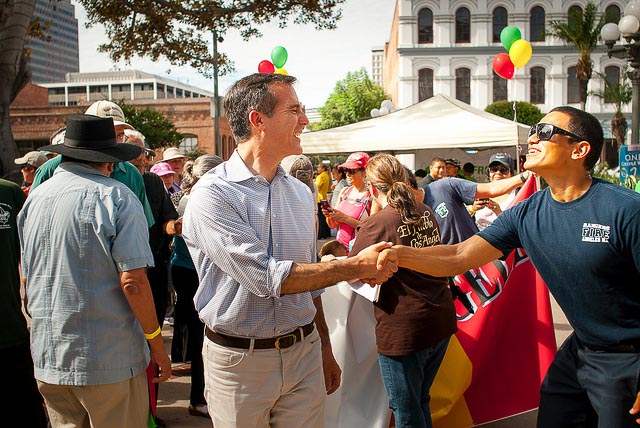Ryan Holeywell | @RyanHoleywell | March 21, 2016
Click here to read the full report on California local elections turnout, produced by the Kinder Institute for Urban Research's Center for Local Elections in American Politics.
 Los Angeles Mayor Eric Garcetti shakes a constituents' hand during the Los Pobladores Walk, which celebrates the founding of the city. Image via flickr/Eric Garcetti.
Los Angeles Mayor Eric Garcetti shakes a constituents' hand during the Los Pobladores Walk, which celebrates the founding of the city. Image via flickr/Eric Garcetti.
When Los Angeles voters elected Eric Garcetti mayor in 2013, it marked several milestones.
Garcetti was the first Jewish person elected mayor of the city. He’s the youngest person ever elected to the office too.
But there’s another point that probably shouldn’t be celebrated. Garcetti won office with fewer votes than any newly elected mayor since the 1930s, when the city was less than half the size it is today, according to the Los Angeles Times.
When the dust settled after the May 21, 2013 election, the city clerk reported that just 23.3 percent of the city's 1.8 million registered voters cast a ballot.
Even if you’re a stranger to Los Angeles politics, the date of that election might give you a clue about why turnout was so poor. The city's primary election was March 5. The general election was May 21.
If you’re like most Americans, you probably think Election Day is some time in November. But for local contests in Los Angeles – like many other cities – elections are held at a lesser-known point on the calendar.
Now, new figures show just how great an effect election timing has on mayoral contests. On average, mayoral elections held off cycle in California have less than half the voter turnout of mayoral elections that coincide with presidential contests.
The finding is part of a new report published by the Kinder Institute for Urban Research’s Center for Local Elections in American Politics, housed at Rice University in Houston. The California study is the first of nearly a dozen state-by-state reports to be released this year that detail trends in local elections, based on the Center’s database of thousands of local election results nationwide dating as far back as the early 1980s.
It’s not hard to understand why off-cycle elections often translate to low turnout. Many voters face barriers to registering and participating in them. A lack of media and party attention to local races sometimes makes it harder to learn about local candidates, polling locations, and hours. When voters have to take time off from work to cast their ballots, the lack of a presidential contest may leave them with insufficient incentive to make the trip to the polls.
Importantly, the effects of this trend are most pronounced in California’s largest cities, which hold a disproportionately large number of off-cycle elections. And it’s particularly acute in Los Angeles County, home to 69 percent of the state’s off-cycle mayoral contests.
So why is this happening? It may have been an intentional strategy. The scheduling of off-cycle municipal elections originated in the Progressive Era, during the late 1800s and early 1900s, when reformers believed separating local politics from state and national elections would benefit democracy. The switch was also thought to undermine powerful party machines (and at the same, not coincidentally, help those very same reformers win office).
Today, it’s clear that off-cycle elections are actually suppressing participation in local democracy. And it likely isn’t a trend confined to California. The good news is research shows that when local governments choose to go on-cycle and align their contests with Election Day in November, there’s a rebound effect. Turnout starts to increase.
State policymakers are aware of this phenomenon. Last year, California adopted SB 415, which requires cities with especially low voter turnout to consolidate their contests with the state elections. The law takes effect Jan. 1, 2018.
Its sponsor, state Sen. Ben Hueso (D – San Diego), argued the switch was necessary because low turnout in local elections results in political bodies that don’t actually resemble the population of their communities. If elections are held concurrently with statewide races, he argued, turnout would increase, “voter fatigue” would decrease and citizens would form a habit of participating in local elections.
But cities don’t have to wait until their turnout falls to the thresholds that trigger a switch under SB 415.
LEAP authors Melissa Marschall and John Lappie identified 16 California cities that moved from off-cycle elections to on-cycle elections between 1995 and 2014. Before they switched, the cities averaged turnout of 21.4 percent in their mayoral contests. But after changing the timing of local races to align with presidential or Congressional midterm elections, turnout averaged 36.3 percent, an increase of nearly 15 percentage points.
Lawmakers often talk about the need to increase voter participation and civic engagement. We now know there’s clear evidence to support the notion that simply changing election dates can accomplish this. All that’s required is the political will to do so.

